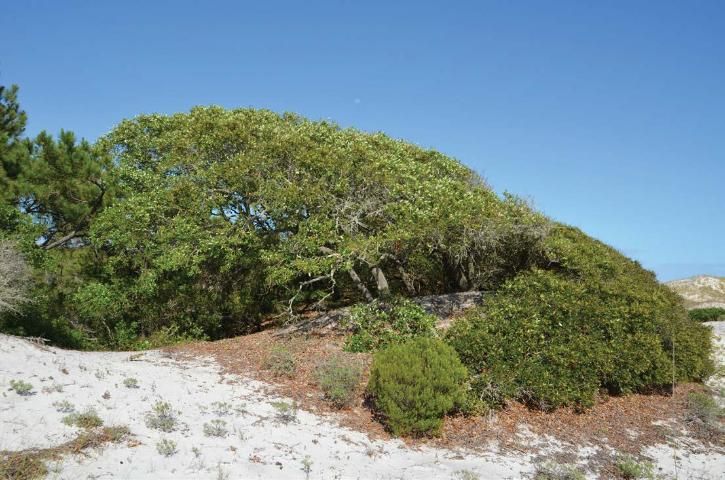Note: This fact sheet is also available as a chapter in a comprehensive manual titled Dune Restoration and Enhancement for the Florida Panhandle, available in pdf form here: https://edis.ifas.ufl.edu/pdffiles/SG/SG15600.pdf. Please see the manual for more information about other useful and attractive native plants for dunes and for further information about restoration and preservation techniques.
Fagaceae

Credit: Mack Thetford, UF/IFAS
Sand live oak is found throughout northern Florida, more broadly west to Louisiana, and northeast to North Carolina. It is found in beach dunes, backdunes, sandhills, coastal areas, and inland areas with deep sandy soils. While this plant forms trees farther inland, it is commonly reduced to shrubs and sub-shrubs because of the extreme environmental conditions of the coast. The acorns of this plant are a valuable food source for wildlife. Sand live oak is available also in commercial nurseries and is often used as a landscape plant.
General Description
Sand live oak is within the white oak group and may be present as a shrub or tree with thick, roughly ridged, furrowed bark. The white oak group (synonym sect. Lepidobalanus or Leucobalanus) produce acorns that mature in 6 months (current season growth) and are frequently described as sweet or slightly bitter. Leaves are alternate, simple, thick, coriaceous, coarsely veined and 0.75 to 5 in long by 0.25 to 1.5 in wide. Upper leaf surfaces are dark green and glabrous, lower surfaces are dull gray to white and pubescent, and petioles are densely pubescent. Leaf margins are revolute, and the leaf blade is cupped, which gives it the shape of a boat. Inflorescences are catkins that appear in spring. Fruits are acorns, 0.4 to 0.8 in long and pointed; borne in a tapering cup that is about 0.3 in deep and has imbricate scales.
Propagation
Cutting propagation of sand live oak is not a practical approach for oak restoration because it would limit genetic diversity. Propagation from seed is accomplished easily. Acorns of Q. geminata are viviparous. The radical of the embryo does not stop growing necessitating immediate planting following seed harvest. Select acorns that are brown as yellowish acorns are generally not mature. Mature acorns will easily separate from the acorn cup. Collect acorns from branches rather than from the ground to minimize the collection of seeds containing weevil larvae. Perform a standard float test (discard those that float in water) to help eliminate acorns with underdeveloped seed and many impacted by weevils.

Credit: Gabriel Campbell, UF/IFAS
Acorns can be planted on the surface of a well-drained production substrate or the acorns may be covered lightly to a depth equal to the acorn diameter. Shoot emergence follows initial root system development.
Outplanting
Protect seeds planted in the wild from herbivores and high salinities. Bury them in the soil at a depth approximately the diameter of the acorn (Lumban Tobing 2009). Polyacrylamide gel is not recommended for outplanting of nursery-grown transplants from containers (Miller et al. 2013). The authors suggest outplanting in association with depressions to mimic natural dune-building processes that occur with sand accretion, to reduce initial drought stress, and to use explants with a deep root volume.

Credit: Gabriel Campbell, UF/IFAS
Literature Cited
Griffin, J., and N. Bassuk. 1996. Preliminary progress on the asexual propagation of oaks. Combined Proceedings, International Plant Propagators' Society 46:487–494.
Lumban Tobing, S.T. 2009. "Germination and establishment of woody species with barrier island interdunal swales." Master's thesis. University of Florida.
Miller, D.L., M. Thetford, and L.W. Atwood. 2013. "Effect of polyacrylamide gel on woody plant establishment in barrier island swales." Natural Areas Journal 33(4):500–508.